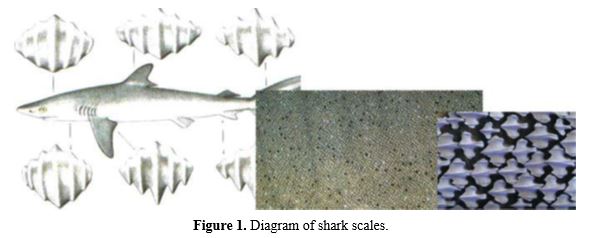
Nanotechnology researchers at Flinders University in South Australia are looking closely, extremely closely, at shark skin and dragonfly wings in the hope of finding solutions to a number of maritime and medical mysteries. According to the researchers, the microscopic makeup of these natural surfaces may hold the key to better applications in human technologies.
‘Our study looked at the special structure of the ribletted surfaces of some sharks, which enable them to reduce drag and friction while also deterring microscopic marine organisms from adhering to their skin,’ said Professor Youhong Tang from the College of Science and Engineering. ‘The shape of riblets on the skin surface influences the effectiveness of the drag reduction greatly, with the riblet surfaces performing best when aligned parallel to the flow direction.’
Led by Chinese naval architecture and ocean design and engineering collaborators, the research is focusing on developing a simple biomimetic turbulent-drag-reduction topology for research modelling. This will be used to guide the design of more fuel-efficient marine surfaces for applications in cargo ship hulls and pipelines that also may not be as prone to attracting aquatic biofilm build-up, which causes drag on ship hulls.
Another team of researchers is investigating the antibacterial properties of insect wings. ‘The wings of dragonflies and cicadas have evolved to use the structural features of their surface to attain bactericidal properties,’ said Vi Khanh Truong from the Flinders Biomedical Nanoengineering Laboratory. ‘The nanopillars or nanospikes present on these natural materials physically damage the bacterial cells that settle on the nanostructures, resulting in cell lysis and death. This study looks at these natural surfaces to provide guidelines for the design of synthetic bio-inspired materials and also create some novel fabrication techniques used to produce biomimetic micro- and nano-structures on synthetic material surfaces.’
Antibiotic-resistant bacteria claim an estimated 700,000 lives each year. This is predicted to increase to ten million by 2050 if drug-resistant bacteria continue to evolve at the same rate. The build-up of microbial biofilms – havens for infection-causing bacteria – on hospital and instrument surfaces thus poses a significant challenge to human health.
Scientists are developing antibacterial and antifouling materials to combat the increasing risk associated with bacterial infections and the evolution of drug-resistant bacteria by developing man-made coatings made from bactericidal agents such as metal derivatives or antibiotics.
The research has been published in Sustainability and Advanced Materials Interface.



